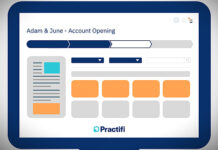By Adrian Johnstone, Practifi
You would have difficulty finding a financial advisor who doesn’t use some kind of client relationship management (CRM) system. Tools for organising and nurturing clients have been around for decades, but simply possessing a CRM system doesn’t equate to great client service.
Like any tool, a CRM system’s effectiveness depends on the skill and knowledge of the individual using it. The average person can chip away at a stone with a chisel and produce nothing but gravel. In a sculptors hand, that same tool produces works of beauty. By taking the time to understand common CRM mistakes, you can avoid them in the future and set up your advice firm for success.
Here are five mistakes to avoid when using a CRM:
1. Using a generic dashboard
If you’ve ever worn tailored clothing, you understand the difference customisation can make. Generic solutions designed to fit the widest possible group of people will always fall short of more flexible tools.
Every advice firm is different, and within each firm every person has a different job. Assuming that all of these roles require the same information is a mistake. Configurable dashboards are preferable because they empower individuals to take control of their workflow. Tailored solutions help streamline processes by ensuring everyone has immediate and easy access to the clients, dates, tasks and alerts most relevant to their roles.
2. Only using one or two CRM features
Years ago, CRM systems were essentially databases where advisors could store and easily retrieve information about clients. While this is still a core function of today’s systems, it’s far from the only one. From lead management to sales analytics, from buyer behavior forecasting to direct customer support interaction models, using your CRM system only as a digital repository for client information is a mistake because it ignores other value-added features.
Using your CRM’s automation tools can, for example, speed up your workflow and therefore give you more face time with your clients. Even better, the ability of a CRM to synthesize client data into real-time visualizations of your company’s growth allows you to zero in quickly on areas of opportunity. Growth-oriented advisors should use every available CRM feature so they can maintain strong relationships with current clients while sourcing and nurturing prospects at the same time.
3. Not integrating the CRM with other tools
Alone, a CRM system is a powerful tool for business success. Combined with other digital tools, it becomes a supercharged engine. Integrating marketing and business management tools gives you the ability to grow with confidence.
For example, integrating your CRM with a document management solution can make your workflows more efficient. You can easily request signatures and store sensitive information in a secure repository. This ensures you have access to the right files when you need them with the assurance that they are only available to authorised individuals.
4. Relying on vanity metrics
It’s a mistake to focus on metrics that look great in a report but do little to enhance your bottom line. Vanity metrics like the number of prospects you contact each month are interesting to look at, but what value do they actually add?
An effective CRM helps you visualise metrics that are actually meaningful to your continued growth. For instance, by looking at engagement and conversion metrics, you can identify which of your marketing efforts bring in the most business opportunities, not just the ones that are viewed the most. Every firm has unique metrics, so consider auditing yours to ensure you’re focusing on the right ones.
5. Ignoring growth opportunities
Some advisors make the mistake of treating every prospect equally. The truth is that some prospects are more valuable than others.
You may be ignoring growth opportunities by attempting to treat every prospect equally. A CRM system should do more than simply track interactions, it should help you understand which ones will bring the most value to your firm. When you understand the difference between low- and high-potential prospects, you can focus more of your resources on ones who are likely to convert.
When you use technology designed for growth and scalability, you’ll have more opportunities to make lasting connexions with your clients.








